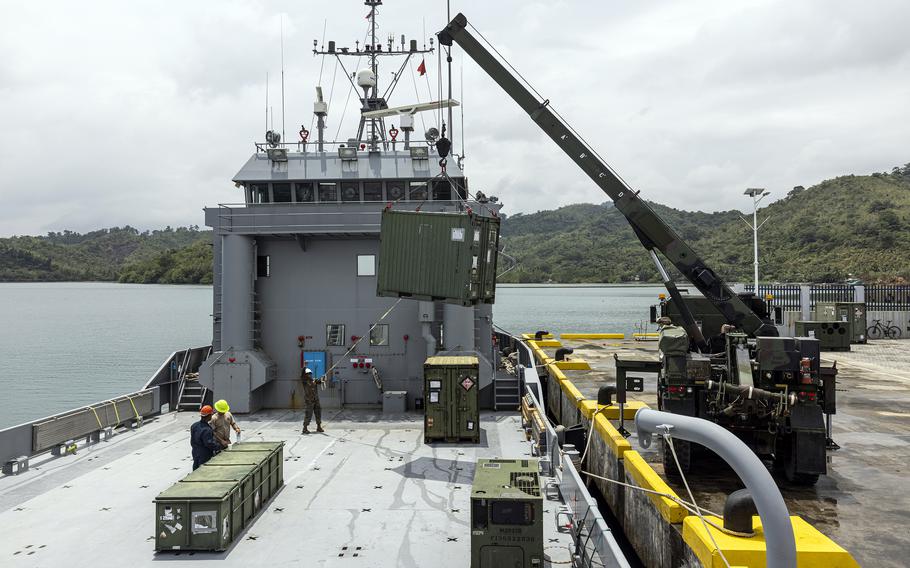
A container is loaded onto a U.S. Army landing craft at Camp Agnew, Casiguran, Philippines, in April 2023. (Danny Gonzalez/U.S. Marine Corps)
The U.S. Army trimmed its watercraft fleet by half over the past six years, even as demand for those vessels increased, particularly in the Indo-Pacific region, according to a federal watchdog agency’s recent report.
As of May, the Army’s watercraft fleet had shrunk to 70 vessels from 134 in 2018, according to the report released Wednesday by the U.S. Government Accountability Office.
The Army’s fleet moves supplies, equipment and personnel in deep ocean, shallow coastal waters, inland waterways and rivers.
The watercraft gap has left the Army far short of its mission-capability goal of 90% of equipment being ready and available to perform missions, according to the report. The fully mission capable rate for watercraft has steadily declined from 75% in 2020 to less than 40% this year.
The Army’s watercraft fleet is a “key enabler” of the joint force, particularly in the Indo-Pacific, the Defense Department’s priority theater,” the report states.
“Within this region, China is recognized as the only country that poses a military, technological, and economic challenge to the United States and its regional partners and allies,” the report states. “China has set a timeline for its military to be capable of taking Taiwan by 2027 and, according to DOD, recent events in the Taiwan Strait have some questioning the prospects of a near-term invasion.”
Army watercraft vessels are stationed at two U.S. locations, Virginia and Hawaii, and two locations in Japan, Yokohama and Naha, Okinawa, the report states.
In the Pacific, the watercraft participate in exercises such as Talisman Saber in Australia and Balikatan in the Philippines.
Eight of the Army’s vessels were involved in construction of a temporary pier off the coast of Gaza in support of humanitarian aid.
The challenges facing the Army’s current watercraft fleet are wide-ranging, but central to the difficulty are the repercussions of the Army’s decision a few years ago to divest itself of watercraft.
In 2018, the commander of the Army Materiel Command recommended to Secretary of the Army Mark Esper that the service could save more than $140 million each year by transferring its watercraft capabilities to other service branches or outside entities.
In May 2019, the Army moved to partially divest and inactivate part of the fleet, resulting in the sale of 64 vessels and the termination of funding for all Army Reserve Component vessels, the report states. Among the vessels purged from the fleet were 27 landing craft mechanized, 16 large and small tugs and 17 landing craft utility.
Some lawmakers objected to the draw down, and language in the 2020 National Defense Authorization Act prohibited further inactivation of Army watercraft until the Defense Department completed a review on the Army’s ability to meet the requirements of the combatant commands.
The Army is working on a revised watercraft modernization strategy, expected to be completed early next year, which looks at watercraft needs from 2030 to 2040, but “it remains unclear whether it will include any mitigation plans to address the current challenges, risks, and gaps affecting the watercraft fleet,” the report states.
This winter, the Army established the Watercraft Enterprise Governance Board to provide oversight and coordination of the service’s world-wide watercraft activities.
The Army’s 70 watercraft are evenly divided between U.S. Army Pacific and U.S. Army Forces Command, but most missions are in the Pacific.
Despite the vessel shortfall, the Army plans to increase the number of missions for watercraft from 37 in fiscal year 2023 to 46 in the fiscal year that began on Oct. 1. U.S. Army Pacific will conduct about 61% of the missions this year, the report states.
The GAO recommended that the Army, in consultation with the commanders of Indo-Pacific Command and Army Pacific, develop a plan to reduce risks due to gaps in watercraft capability and capacity in the near term.
It also recommended that the Army’s Watercraft Governance Board develop a governance framework that reflects best practices as defined by the GAO.